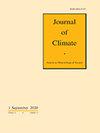Using the observed variations of the start date of the rainy season over Central America for its reliable seasonal outlook
IF 4
2区 地球科学
Q1 METEOROLOGY & ATMOSPHERIC SCIENCES
引用次数: 0
Abstract
Abstract We introduce a simple method to define the start and the end of the rainiest part of the year as the first and the last day of the year when the daily rain rate is more or less than the annual mean climatological rain rate for a region or at a given grid point of the rainfall analysis, respectively. A novelty of this work is the adoption of a perturbation technique to generate a total of 1001 ensemble members to account for observational and analysis uncertainties. This allows for a probabilistic estimate of the start and retreat dates of the rainy season at the granularity of the Integrated Multi-Satellite Retrievals for Global Precipitation Mission version 6 (IMERG) rainfall analysis over Central America. The seasonal cycle of the IMERG rainfall analysis is also found to verify with in situ observations in the region. Many large scale climate drivers affect regional rainfall, often with complex interactions that affect the onset date, retreat date, and magnitude of the seasonal rainfall cycle, making it difficult to predict the length or total quantity of seasonal rainfall using climate drivers alone. Once an onset date is established, however, this metric alone can be more indicative of both the length and total seasonal rainfall anomaly than predicting how the climate drivers will interact to affect the quantity and duration of upcoming seasonal rainfall. The local relationships of the start date with seasonal length and rainfall anomaly are leveraged to produce effective seasonal outlooks of the rainy season for the region by just monitoring the start date variations.利用观测到的中美洲雨季开始日期的变化进行可靠的季节展望
摘要 我们介绍了一种简单的方法,将一年中雨量最多的时段的开始和结束分别定义为某地区或降雨分析给定网格点的日降雨量大于或小于气候学年平均降雨量的第一天和最后一天。这项工作的一个新颖之处是采用了扰动技术,生成总共 1001 个集合成员,以考虑观测和分析的不确定性。这样就可以在中美洲全球降水任务多卫星综合检索第六版(IMERG)降雨分析的粒度上对雨季的开始和结束日期进行概率估计。IMERG 降水分析的季节周期也与该地区的实地观测结果相吻合。影响区域降雨的大尺度气候驱动因素很多,通常会产生复杂的相互作用,影响季节性降雨周期的开始日期、消退日期和降雨量,因此很难仅凭气候驱动因素预测季节性降雨的长度或总量。然而,一旦确定了起始日期,仅凭这一指标就能更好地反映季节性降雨异常的长度和总量,而不是预测气候驱动因素将如何相互作用以影响即将到来的季节性降雨的数量和持续时间。利用开始日期与季节长度和降雨异常的局部关系,只需监测开始日期的变化,就能对该地区的雨季做出有效的季节性展望。
本文章由计算机程序翻译,如有差异,请以英文原文为准。
求助全文
约1分钟内获得全文
求助全文
来源期刊

Journal of Climate
地学-气象与大气科学
CiteScore
9.30
自引率
14.30%
发文量
490
审稿时长
7.5 months
期刊介绍:
The Journal of Climate (JCLI) (ISSN: 0894-8755; eISSN: 1520-0442) publishes research that advances basic understanding of the dynamics and physics of the climate system on large spatial scales, including variability of the atmosphere, oceans, land surface, and cryosphere; past, present, and projected future changes in the climate system; and climate simulation and prediction.
 求助内容:
求助内容: 应助结果提醒方式:
应助结果提醒方式:


